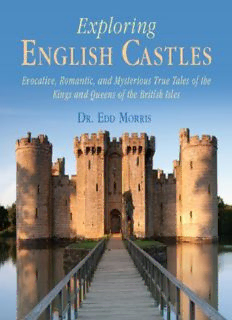
Exploring English Castles : Evocative, Romantic, and Mysterious True Tales of the Kings and Queens of the British Isles PDF
Preview Exploring English Castles : Evocative, Romantic, and Mysterious True Tales of the Kings and Queens of the British Isles
Table of Contents Introduction: A Note for Castle Explorers 1066: A Story of Castles and Conquest Built to Bristle: Attacking and Defending a Medieval Castle Decline and Decay: The End of an Era The Castles Life in a Medieval Castle: Goodrich Dover Castle and the Cult of a Murdered Archbishop Tintagel Castle, and the Legend of King Arthur Forty Fat Pigs, and the Siege of Rochester Castle The Puzzle at the Heart of Bodiam Castle The Siege of Corfe Castle, and the Might of Lady Mary Bankes The Fall of Earl Thomas, and the Ruin of Dunstanburgh Castle Framlingham Castle, and the Tale of England’s First Queen Kenilworth Castle, and a Very Elizabethan Love Story References and Bibliography Acknowledgments Glossary Index Introduction: A Note for Castle Explorers A misty morning breaks over the ruins of Corfe Castle. Like many of the greatest elements of modern-day England—from loose-leaf tea to chicken tikka masala curry—castles were a foreign import. The first of their kind arrived in England in 1051 and was built in rural Herefordshire—a sleepy place that’s, strangely enough, the county where I was born. A beautiful tower within the Norman castle of Lewes, in East Sussex. This founding fortification was a design sensation—imported directly from France, always a place of cutting-edge fashion. To our modern eyes, it certainly wouldn’t have looked like much—it was likely just a mound of earth with scattered wooden fortifications across the top. Despite this, there would have been nothing comparable in Medieval England. As a result, its presence would have felt like an alien spaceship landing in the countryside. The contemporary chroniclers had no word for this new-fangled monstrosity, so they just plumped for the French term: they christened it a castle. This castle was to be the first of many. Come 1066—some fifteen years later—the Normans would invade England from the continent and would build hundreds more of the things. Some would be built with care; others would be thrown together in haste. Either way, the Normans used castles to hold power over their conquered nation. These modern fortifications, in combination with devastating military skill and political cunning, meant that a force of just two thousand disciplined invaders commanded a nation of two million rowdy Anglo-Saxons, all in a matter of months. Quite obviously, these first castles don’t look at all like the castles of our imaginations. Indeed, if I asked you now to visualize a castle, I doubt you’d dream of a muddy hillock topped with a timber fence. Over time, this fortification evolved, and the word castle began to mean something quite different. The 1100s and 1200s signified a special species of gray stone monster: a structure bristling with grand towers, great keeps, curtain walls, jagged crenellations, fortified gatehouses, and swinging drawbridges. The alluring path through Colton’s Gate, in Dover Castle. Just beyond lies the Great Tower. The central question, then, is what makes a castle a castle? After all, the earthen mound and gray stone enclosure are superficially very different beasts, yet we use the same word for each. Essentially—and I’d be quick to emphasize that this is my opinion from my own explorations, rather than the result of a lengthy academic endeavor—I believe a castle is an intriguing mix of high-status accommodation and hard-wrought defense. Those first Norman castles were called motte and bailey, where the motte was the defensive earth mound and the bailey was an enclosed courtyard for domestic use. Late medieval castles evolved to feature all those castle-y accoutrements we love so much (towers, arrow-slits, moats, and the like), but also housed grand tapestried rooms and gilded chambers fit for a king or queen. The thick wooden door of Stokesay Castle in Shropshire.
Description: